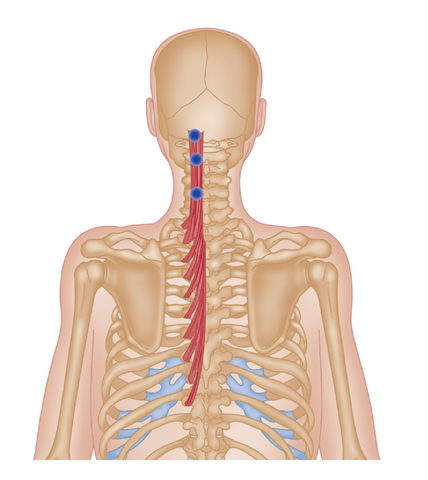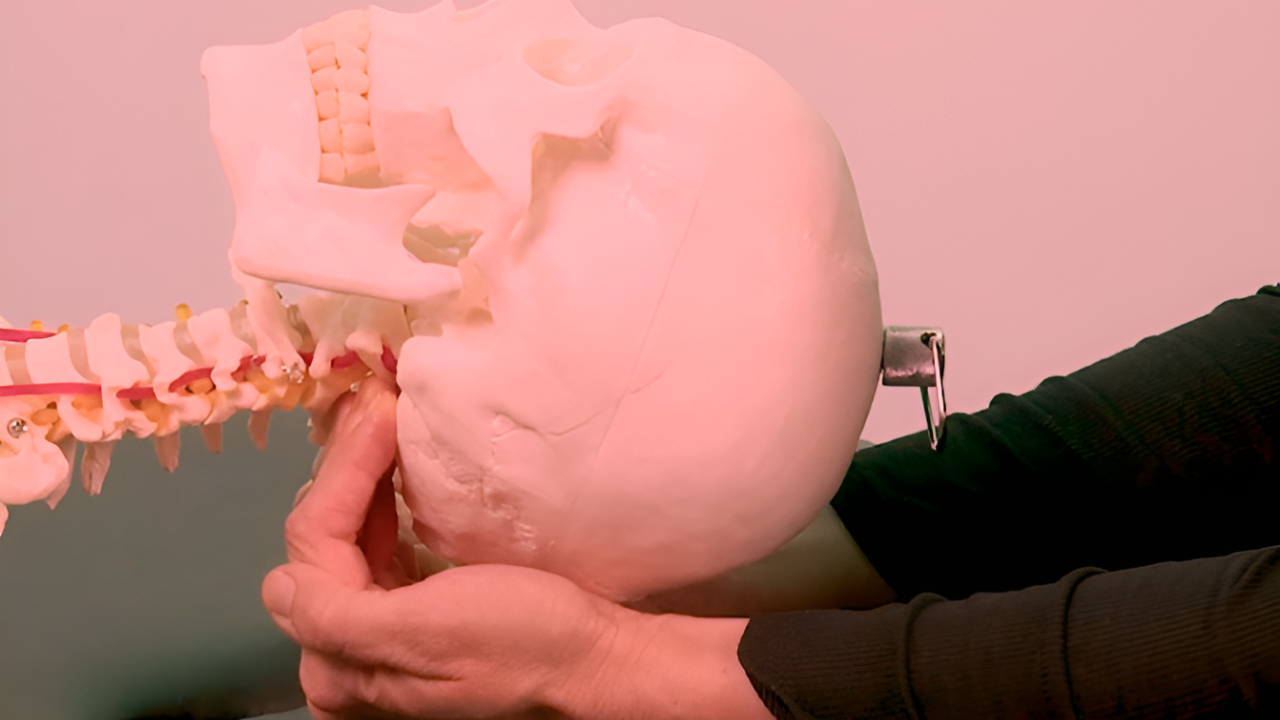Treating Whiplash - Torsional Release Technique
Treating neck stiffness and pain with torsional release technique - Dr. Jonathan Kuttner
NAT Trigger Point Master Course
Long lasting cases of whiplash are often caused by a failure to treat satellite trigger points
Whiplash injury occurs when there is sudden flexion and/or extension of the neck.
In contact sports this usually occurs when the athlete is struck from behind, and the head is rapidly thrown both forward and backward.
Car accidents are of course one of the most commonly discussed causes.
Soft tissues of the neck including intervertebral discs, ligaments, cervical muscles and nerve roots may be injured, producing neck pain, stiffness and loss of mobility.

Hips, Back and Trunk
The hips, back and trunk are the first body segments and joints to experience movement during a whiplash. Forward motion in these structures is accompanied by upward motion, which acts to compress the cervical spine.
This combined motion causes the head to move backward into extension, producing tension where the lower cervical segment extends and the upper cervical segment flexes.
With this movement of the cervical vertebrae, the anterior structures are separated and posterior components including facet joints are severely compressed.
What Are the Symptoms of Whiplash Injury?
The most common symptoms of whiplash are:
• Pain and tightness in the neck when moving the head• Muscles of the neck may feel hard or knotted
• Headaches
• Ringing in the ears
• Sleep disturbance
Other Associated Symptoms
• Fatigue
• Weakness
• Visual disturbances
• Jaw pain
Chronic Pain is the Main Symptom of Long-Term Whiplash
The symptoms of whiplash may appear immediately after the blow or may take hours or days to appear. Most people recover from whiplash after a few months, however in some cases the client will be suffering symptoms for up to a year and even longer.
In our experience of treating many of these long term cases, we find that they are almost always associated with chronic pain as the overriding symptom.
Who is Prone to Whiplash Injury?
Anyone who has been in a motor accident, especially in a rear-end collision is at risk of suffering from whiplash.
Other people at risk include amateur and professional athletes who often suffer blows to their head and neck - such as footballer tacklers.
Roller coasters and other amusement park rides have been known to cause whiplash Injury, and physical abuse is another common cause, especially when one has been punched or shaken violently.
We also often see cases where whiplash has occurred as a result of everyday activities, for example jolting the neck when one trips or falls. Again, this is more common with a slightly older age group.
Studies have found that whiplash is more common in women than men. Women's neck muscles are generally not as strong as men’s and as a result suffer greater trauma from a sudden jolt.
Differential Diagnosis - What Else Could It Be?
Here is a list of other conditions which can present as whiplash pain:
Traumatic:-
• Traumatic Brain Injury
Bones and discs:-
• Spinal prolapsed or bulging disc with radiculopathy
• Spinal Stenosis (narrowing of the vertebral nerve exits)
• Neck (Cervical) Osteoarthritis
• Spondylolysthesis/Retrolysthesis
Other:-
• Facticious Disorder
• Psychogenic Pain Disorder
• Vascular abnormality of neck blood vessel structures
• Polymyalgia Rheumatica
• Neoplastic (cancers)
• Referred pain from cardiothoracic structures
Rehabilitation and Prevention
The neck will usually be immobilized with some form of brace, though early movement is usually encouraged to prevent stiffening.
Low-impact strength and flexibility training and rehabilitation should follow complete healing of the tendons, discs and ligaments.

Sternocleidomastoideus (SCM) - Common Trigger Point Sites
Trigger Point Therapy
Whiplash is a condition that almost all manual therapists will claim to be able to treat, and this is generally true.
Anything to do with the neck, and most therapists are in their comfort zone! It's also true that even the most basic massage therapy is likely to bring some relief.
However in most cases the symptoms of whiplash are associated with trigger points in a number of muscles, including some that can be difficult to treat.
These include the Sternocleidomastoid, Upper Trapezius, Semispinalis Capitis, Splenius Capitis, Splenius Cervicis, and Scalenes. Long term cases of whiplash are often a result of a failure to treat trigger points.
Long-Term Prognosis
The long-term prognosis for most whiplash injuries is good, given adequate care, though symptoms may persist and the neck may be prone to re-injury. As stated above, total rehabilitation is often linked to treating satellite trigger points.
Links
Find a Trigger Point Professional in your area
More Articles About Elbow Pain
Dry Needling for Trigger Points
Certify as a Trigger Point Therapist
About NAT Courses
As a manual therapist or exercise professional, there is only one way to expand your business - education!
Learning more skills increases the services that you offer and provides more opportunity for specialization.
Every NAT course is designed to build on what you already know, to empower you to treat more clients and grow your practice, with a minimal investment in time and money.
Help Desk
NAMTPT AWARD
We are honored to have received the 2017 "Excellence in Education" Award from the National Association of Myofascial Trigger Point Therapists.
Since 1999 Niel Asher Education has won numerous awards for education and in particular for education and services provided in the field of trigger point therapy.
Read Full Article
About Niel Asher Education
Niel Asher Education is a leading provider of distance learning and continued education courses.
Established in the United Kingdom in 1999, we provide course and distance learning material for therapists and other healthcare professionals in over 40 countries.
Our courses are accredited by over 90 professional associations and national accreditation institutions including the National Academy of Sports Medicine (NASM) and National Certification Board for Therapeutic Massage and Bodywork (NCBTMB). Full details of all international course accreditations can be found on our website.
Printed course materials and other products offered on our websites are despatched worldwide from our 3 locations in the UK (London), USA (Pennsylvania) and Australia (Melbourne).
More About Us
NAT Certification
If you are a qualified/licensed manual therapist or exercise/fitness professional you can expand your credentials with NAT certification.
In addition to national accreditation for continued education, each course that we offer includes "NAT Learning Credits". By taking and completing courses you can accumulate NAT credits to qualify for NAT certification.
There are currently 3 levels of NAT certification. Certifying NAT is a valuable way to show your clients that you take continued education seriously, and to promote your skills and qualifications.
About NAT Certification
Niel Asher Technique
Since 1999 the Niel Asher Technique for treating trigger points has been adopted by over 100,000 therapists worldwide, and has been applied to the treatment of a number of common musculoskeletal injuries.
The Niel Asher Technique for treating frozen shoulder was first introduced and published in 1997 and has been widely adopted by therapists and exercise professionals working within elite sports and athletics.
Read More
This trigger point therapy blog is intended to be used for information purposes only and is not intended to be used for medical diagnosis or treatment or to substitute for a medical diagnosis and/or treatment rendered or prescribed by a physician or competent healthcare professional. This information is designed as educational material, but should not be taken as a recommendation for treatment of any particular person or patient. Always consult your physician if you think you need treatment or if you feel unwell.

Learn More for Less

Unlimited access to all courses for just $19.95/mo











